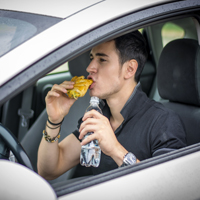Eating While Driving can be Dangerous
October 15, 2017 By now, most people know just how deadly different types of distracted driving can be. Some of the common culprits behind distracted driving are texting and making or receiving phone calls. However, new research indicates that eating and/or drinking while driving may be almost as dangerous as cell phone use.
By now, most people know just how deadly different types of distracted driving can be. Some of the common culprits behind distracted driving are texting and making or receiving phone calls. However, new research indicates that eating and/or drinking while driving may be almost as dangerous as cell phone use.
According to the National Highway Transportation Safety Administration (NHTSA), three main types of distracted driving can put vehicle operators (as well as other drivers and passengers on roadways) at risk. Visual, manual and cognitive distractions, all of which affect a driver’s ability to focus while operating a vehicle, can impair drivers in different ways.
Visual distractions are any distractions that cause drivers to look away from the road and car mirrors, manual distractions are those that cause drivers to remove one or both hands from their steering wheel, and cognitive distractions are those that cause drivers to take their mind off the road. Alone, each of these are dangerous, but in the case of eating or drinking while driving, drivers can become distracted in all three ways simultaneously.
The Centers for Disease Control and Prevention (CDC) report that 9 people are killed every day and another 1,000 are injured as a result of distracted driving. Although drivers under 20-years-old are in the highest number of distracted driving-related fatal automobile crashes, men and women of all ages are equally at risk for becoming distracted behind the wheel.
What is important to remember here is that drivers are in control – for the most part – of whether or not they become distracted while operating a motor vehicle. The more often a driver allows his or herself to become distracted behind the wheel, the greater the likelihood that an accident will happen. This does not just put the driver’s health and life at risk, but also the lives and wellbeing of other drivers.
Although many people may believe that eating or drinking behind the wheel does not pose a major risk, numerous reports and data indicate otherwise. In a 2014 study conducted by Lytx, a global risk management company, researchers determined that drivers who are drinking or eating are 3.6 times more likely to be in a crash than drivers who are not. In a separate study, the NHTSA found that eating or drinking while driving can increase the chances of an accident by as much as 80%.
In a recent survey of 1,000 drivers, ExxonMobil reported that 83% admitted to drinking beverages behind the wheel and 70% said they regularly eat food while driving. In light of how dangerous it can be to eat food or drink beverages behind the wheel, these numbers are certainly concerning. Assuming Exxon’s survey is indicative of answers on a larger scale, it appears as though the majority of American drivers may eat or drink behind the wheel regularly.
According to the NHTSA, certain types of food and beverages are especially dangerous. Why? If a hot beverage spills, the chances of a driver becoming distracted and taking his or her hands off the wheel greatly increases. In fact, according to NHTSA data, hot coffee is one of the most dangerous items for drivers to drink while driving. We have compiled the top ten most dangerous food and beverages from the NHTSA’s list below:
- Chocolate
- Jelly and cream filled or powdered donuts
- Sodas or other soft drinks
- Barbecued food
- Fried chicken
- Tacos
- Hamburgers
- Chili
- Hot Soup
- Coffee
As you can tell, many of these items made the list because they are hot, easy to spill, or make a driver’s hands dirty, sticky and/or greasy. That is exactly why the NHTSA categorizes them as so much more dangerous: because people are likely to try to wipe away spills, clean off their hands or become distracted in other ways when eating or drinking these especially hard-to-handle foods and beverages. While these items top the NHTSA’s list of the most dangerous foods and beverages for drivers to consume, please remember that eating or drinking anything while driving can result in distraction as well as accidents.
Many organizations refer to distracted driving as an “epidemic” – and it very well may be. The NHTSA counted more than 3,400 Americans who died in car accidents because of distracted driving in 2015 alone. An additional 391,000 sustained injuries, ranging from mild to catastrophic. And, every year, hundreds of thousands of people are injured and lose their lives in distracted driving-related accidents. We can all do our part to limit driver distractions behind the wheel by committing to not drinking beverages, eating foods or using our cell phones – and by doing this, we can all help limit the dangers that Americans face on roadways.
Philadelphia Personal Injury Lawyers at Galfand Berger, LLP Pursue Recoveries for Individuals Injured in Automobile Accidents
If you or a loved one has been injured in an automobile accident, please contact our Philadelphia car accident lawyers at Galfand Berger. With offices located in Philadelphia, Bethlehem, Reading and Lancaster, Galfand Berger serves clients throughout Pennsylvania and New Jersey. To schedule a consultation, call us at 800-222-8792 or complete our online contact form.
 Google Screened
Google Screened
